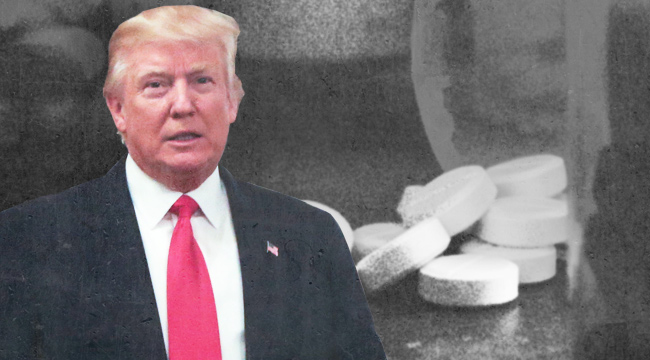
Back in February, President Trump held a particularly divisive press conference wherein he declared that America was “drug-infested” and that drugs were “becoming cheaper than candy bars.” But while the second part was a bit out-of-touch and prone to internet mockery, Trump’s remarks did manage to shed some light on a drug problem that is burning through the country: opioid addiction.
Drug overdoses have been one of the rising causes of death in the United States, causing 33,000 in 2015 alone. While heroin use continues to be an epidemic (with the death from overdoses tripling between 2010 and 2015), the use of prescription opioids accounted for almost half of those deaths.
We now know that overdoses from prescription opioids are a driving factor in the 15-year increase in opioid overdose deaths. Since 1999, the amount of prescription opioids sold in the U.S. nearly quadrupled, yet there has not been an overall change in the amount of pain that Americans report. Deaths from prescription opioids — drugs like oxycodone, hydrocodone, and methadone — have more than quadrupled since 1999.
The link between heroin and prescription painkillers is a problematic one, to be sure. They have a similar effect on the brain, and using one makes you more susceptible to getting hooked on the other, especially for young people. Heroin and fentanyl often go hand in hand as the prescription drug is obtainable legally and illegally and is “50 times stronger than pure heroin.”
The opioid addiction crisis is becoming such a dire situation that there was a life expectancy drop of .1 year reported in December, the first drop in decades. And that’s to say nothing about the impact that addiction has on quality of life. Simply put, we’re dealing with a kind of illness that can rob people of their productivity and life force while taxing families and communities. Love is stretched to the point where it breaks and trust becomes a memory.
With the combination of illegal and legal drugs, the methods of dealing with the problem become increasingly murky. The role of law and order in the in the current drug climate is also a tense one, with law enforcement charging doctors with jail time and the revocation of their medical licenses if they prescribe prescription painkillers without going through the proper channels and protocol. However, one of the positive changes in how the public addresses the current drug epidemic is that protocol is moving away from arrests and towards getting addicts get treatment. But that may become a complicated prospect because one of Trump’s top priorities since assuming office has been repealing Obamacare.
Congress has yet to find a suitable replacement for the current health care market, although they have finally announced a preliminary plan. For people who rely on Medicaid to help offset the cost of mental health and addiction, the most recent proposal offers a short-term extension to the expansion, but there are open questions about funding and an effort to reduce or eliminate minimum coverage standards that could become an issue.
“Nearly 30% of those who got coverage through Medicaid expansion have a mental disorder, such as anxiety or schizophrenia, or an addiction to substances, such as opioids or alcohol, according to the federal Substance Abuse and Mental Health Services Administration. That compares to the more than 20% of the overall population — 68 million people — who experienced a diagnosable mental health or substance abuse disorder in the past year, the American Psychiatric Association says.”
An exchange between Rep. Joe Kennedy III (D-Mass) and a GOP lawyer during a hearing on the proposed ACA repeal and replace bill on February 8 demonstrates the severity of the changes that the bill could usher in if it’s approved in its present state. This specifically applies to those with mental health or substance abuse needs.
Watch GOP lawyers admit that repeal plan will cut off coverage to millions suffering from mental illness & addiction. #ProtectOurCare #ACA pic.twitter.com/nXE3KsRLIN
— Joe Kennedy III (@joekennedy) March 8, 2017
Additionally, as “Trumpcare” continues to evolve, staggering proposed cuts to programs like Medicaid continue to emerge. Oregon senator Ron Wyden highlighted the groups that would be affected by the changes, pointing out that it would be some of our nation’s most vulnerable.
#TrumpCare guts #Medicaid by $880,000,000,000. Completely contrary to every promise Trump made.
— Ron Wyden (@RonWyden) March 13, 2017
While the “Trumpcare” proposals may be lacking for addiction treatment, the problem continues to weigh on Trump’s mind, at least. Perhaps that’s why he has spoken about making the drug naloxone (naloxone hydrochloride), a drug that can temporarily reverse the effects of an overdose from drugs like heroin, OxyContin, and Percocet, more accessible.
By temporarily holding off the effects of a fatal overdose, many users are able to receive the potentially lifesaving care that they need. However, the cost of this drug grows increasingly prohibitive, with Time reporting skyrocketing prices:
Evzio, a form of naloxone manufactured by Kaléo that’s administered through auto-injection, rose from $575 per package in 2014 to a whopping $4,100 in 2016. Another version of the drug, made by Hospira, has risen from $9.20 for 10 vials in 2005 to $158.30 in 2014, according to Truven Health Analytics. The price of the naloxone nasal spray Narcan has remained stable—around $125 for a two-pack—since it was approved by the FDA in 2015.
Trump has said, repeatedly, that he intends on pushing pharmaceutical companies to bring down prices. Maybe that will impact the cost of Naloxone and maybe it won’t, but the bottom line is that this is a fight that needs a lot more than a pill.
